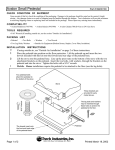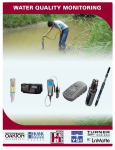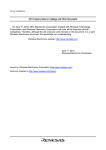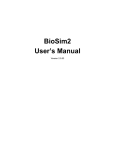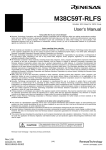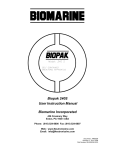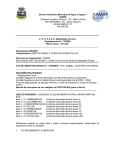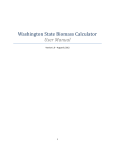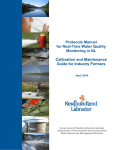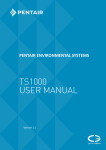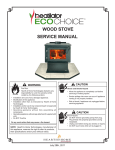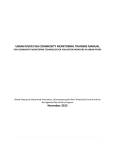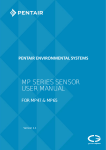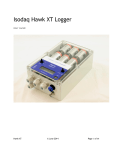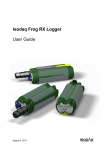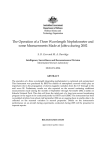Download Water Quality Protocol - The Confederated Tribes Of The Colville
Transcript
Field Manual Okanogan Monitoring and Evaluation Program WATER QUALITY SAMPLING PROTOCOLS November 23, 2005 Prepared by The Colville Confederated Tribes John Arterburn Keith Kistler Michael Rayton TABLE OF CONTENTS Introduction......................................................................................3 Methods............................................................................................3 Temperature Data loggers.................................................... 4 Water Quality Sampling Parameters................................... 6 Nutrient Sampling............................................................... 9 Data Management............................................................... 10 QA/QC........................................................................................... 10 Literature Cited............................................................................. 12 Appendix A....................................................................................14 Appendix B....................................................................................16 2 INTRODUCTION This Field Manual was developed by the Colville Confederated Tribes’ Okanogan Basin Monitoring and Evaluation Program (OBMEP) to provide specific guidance for evaluating and monitoring water quality in the Okanogan subbasin. OBMEP is a long term, status and trend monitoring program that is subject to future modification, therefore, this Field Manual should be considered to be a "living document" with the following protocol potentially subject to some level of change over time as new information becomes available. The protocols contained within this Manual are a conglomeration of methods employed by the Colville Confederated Tribes, the United States Geological Survey (USGS) and the Washington State Department of Ecology (WSDOE) water monitoring program. The Colville Confederated Tribes will be collecting data at established EMAP sites and selected USGS and WDOE gauging stations throughout the Okanogan Basin. We will also be compiling data collected by the USGS, the WSDOE and Environment Canada. METHODS Water Quality information will be collected at all EMAP sites located on tributary streams of the Okanogan River as identified in the CCT physical habitat protocol. Selected locations on the Okanogan and Similkameen Rivers will also be surveyed. Temperature will be monitored with Onset® temperature data loggers in the tributaries and downloaded from USGS and WDOE gauging stations from the mainstem sites. Water quality variables will be collected with a Eureka Manta® water quality probe and recorded in the field on a Eureka Amphibian® field recorder. Samples will be collected up to three times a month at annual and rotating panel sites. A schedule will be created by the fisheries biologist and a water quality technician for the contract year. Each site will be described in detail including: the most efficient access to the site, the GPS location that the sample will be taken and the method needed to access the site. A temperature logger metadata sheet for recording pertinent location information and logger settings is provided in Appendix A. 3 I. Temperature Data loggers We will be using Onset®, optical stowaway temperature data loggers. Each data logger will need to be activated in the office using Boxcar Pro software. (See Boxcar Pro software®) Data logger calibration Ensure the data logger has a fresh battery. Connect the logger to your computer and set it to begin storing data according to the manufacturer’s instructions. Be sure to set the measurement interval to one minute, set the measurement units to degrees C, set the start time and date to the day you are launching and to the nearest hour you are at time of launching. Be sure the clocks in the computer, in the logger, and on the clock used for instantaneous measurements are consistent. It is most efficient to calibrate a number of loggers at the same time. Prepare two water baths in a temperature controlled environment, the first containing ice water in a large cooler or other covered and insulated container. The second bath should be held at room temperature. Verify that each bath is of uniform temperature; mixing may be required. Place the launched loggers in one of the baths for approximately 15 minutes, or long enough to equilibrate to the temperature of the bath. After the equilibration period, measure and record instantaneous water bath temperatures as close to the time the logger is recording a measurement value as possible. Use a laboratory thermometer certified accurate at a minimum of every 10 C by the National Institute of Standards and Technology (NIST) for the instantaneous measurements. Concurrently, record date and time of each quality assurance measurement. Once the instantaneous water bath temperature measurements have been recorded, place the loggers in the second bath and repeat the process. An example of a logger calibration form is provided in Appendix B. Once the logger has been exposed to the range of temperatures anticipated in the field and the measurements recorded, remove the loggers from the water bath, then download and display the data. Compare the logger data to the instantaneous thermometer data. Loggers are acceptable for deployment only if their accuracy is within ± 0.7C of the instantaneous measurements. New loggers that exceed the 0.7C tolerance limit should be returned to the manufacturer for adjustment or replacement. 4 Launching & Deployment Once the data logger has been calibrated it is ready for field deployment. Open Boxcar Pro from the desktop of the computer. Plug the logger into the optic base station. Click logger on the toolbar and then click launch. Name the logger using the following convention: stream name, the site number and the year to be sampled (i.e. Bonaparte_366_2006). Set the interval to one hour sampling. Do not use the one minute time interval as described in the data logger calibration section described above. Click delayed launch, click on the calendar and choose today, the day you are launching and then choose 1700 as the hour to begin recording. Once this has been completed for all the data loggers to launch that day, you can head to the field for deployment. Deployment in tributary streams of the Okanogan River will be put at the center point (X point) of the EMAP site. Each data logger will be placed in the thalweg of the stream, or in an area of the stream where there is adequate, year round flow and water coverage. Where possible, use a duckbill® anchor pounded into the thalweg of the stream with a hammer and applicator. The anchor will be inserted as far as possible into the stream bed, or up to eighteen inches. If the duckbill anchor cannot be driven at least six inches into the streambed, find an alternate location within the thalweg to drive the anchor. If a suitable anchor point cannot be established in the thalweg, place the into the stream bank in line with the center point. The temperature probe will be held and protected by an aluminum sleeve, connected to the anchor with 1/8’ steel cable. The cable will be long enough to retrieve the temperature monitor in high flow conditions if necessary. Keep in mind that each site presents a unique set of circumstances that will be needed to be assessed and dealt with in the field. Data loggers will be deployed at all annual and panel tributary sites using the water year of October to October for analysis, rather than the standard calendar year. Annual sites will be monitored continuously throughout the study. Data will be downloaded in the field using an optic shuttle every October and the data logger then left in the field to begin collecting data for the next year. Panel site data loggers will be deployed in the October prior to habitat sampling, then retrieved the following October for download and redeployment to the next panel site. Onset© suggests the battery in each logger be replaced after 60 months (5 years) of continuous deployment. The loggers will need to be monitored for battery power, and when appropriate, returned to Onset© for new batteries. In addition to this temperature data, the Colville Tribes will compile temperature data collected by the Washington State Department of Ecology (WSDOE), the United States Geological Survey (USGS) and the Okanogan Conservation District (OCD) from tributary streams in the Okanogan basin. For the Similkameen and mainstem Okanogan 5 Rivers we will compile data collected by the USGS and WSDOE for that contract year and any historical data available. II. Water Quality Sampling Parameters Streamside measurements will be made using a Eureka® Manta Multiprobe and recorded on a Eureka® Amphibian Field Data Recorder. Measured parameters include: conductivity, dissolved oxygen (DO), pH, turbidity and temperature. Conductivity Specific conductance (or conductivity) is a measure of the water’s ability to pass an electrical current. This ability is dependant upon the presence of ions, their total concentration, mobility, valence and on the ambient temperature. Solutions of most inorganic compounds are relatively good conductors while solutions of organic compounds that do not easily dissociate in water conduct electricity very poorly. Conductance, G, is defined as the reciprocal of resistance, R: G=1/R. Most conductivity meters do not display the actual solution conductance, G, or resistance, R; rather, they generally have a dial that permits the user to adjust the internal cell constant to match the conductivity, Ks, of a standard. Once the cell constant has been determined, or set, the conductivity of an unknown solution will be displayed by the meter. Ku= CGu. Most problems in obtaining good data with conductivity monitoring equipment can be attributed to fouled electrodes and improper sampling technique. Make sure the equipment is serviced regularly and that the sample is well circulated while obtaining a measurement. Dissolved Oxygen In natural waters, oxygen is essential for the survival of most aquatic organisms. Measures of DO are used to assess water quality and the potential for healthy aerobic organism populations. Dissolved oxygen levels depend on the physical, chemical and biochemical activity in the water body. A dissolved oxygen (DO) reading is a measurement of oxygen dissolved in an aqueous solution. Oxygen concentration levels vary in response to changes in atmospheric pressure and water temperature. The higher the atmospheric pressure, the higher the oxygen solubility in water and the higher the DO concentration. The opposite is true with temperature, the higher the temperature the lower the solubility and saturation concentration of oxygen in water. DO is one of the major factors determining the type of biological communities inhabiting aquatic systems. The addition of organic or inorganic material creates a biological oxygen demand (BOD) through respiration and 6 biodegradation of biological organisms. Waterbodies with a high BOD have lower DO concentrations. This process can facilitate the growth of nuisance organisms and change ecosystem structure and function. We will be employing the membrane electrode method as defined in Clesceri, Greenberg and Eaton, 1998. The sensing element of a membrane-covered electrode system is protected from impurities by an oxygen-permeable plastic membrane. The membrane electrodes are completely submersible, portable, easy to operate and maintain. Because membrane electrodes offer the advantage of analysis in situ, they eliminate errors caused by sample handling and storage. Membrane electrodes provide an excellent method for DO analysis (Clesceri et al.) pH pH is defined as the negative logarithm of the hydrogen ion concentration. pH values range from 0, which is highly acidic, to 14, which is highly alkaline. A measurement of 7 is considered neutral. Each pH unit represents a tenfold change in the hydrogen ion concentration. Natural waters usually fall within a range of 4 to 9. pH levels slightly higher than neutral are slightly basic and can be attributed to the presence of bicarbonates and carbonates of the alkali and alkaline earth metals. Washington waters typically range from 6.5 to 8.5. Measurement of pH is one of the most important and frequently used tests in water chemistry. The basic principle of electrometric pH measurement is determination of the activity of the hydrogen ions by potentiometric measurement using a standard hydrogen electrode and a reference electrode. The hydrogen electrode consists of a platinum electrode across which hydrogen gas is bubbled at a pressure of 101 kPa. In our case we will be using a glass electrode, which eliminates the potential for poisoning the hydrogen electrode. The electromotive force (emf) produced in the glass electrode system varies linearly with pH. This linear relationship is described by plotting the measured emf against the pH of different buffers. A pH sample is determined by extrapolation. Make sure the glass electrode is clean and relatively free from interference from color, turbidity, colloidal matter, oxidants or reductants. pH measurements will be taken in flowing areas of the stream. Use a thermometer to take a stream temperature reading as pH will be reported with the corresponding temperature. The pH meter has a resolution of .01 units which is beyond the recommended accuracy (Clesceri et al.) Turbidity Turbidity measures the ability of water to scatter or absorb light. Turbidity represents a decrease in water clarity caused by suspended and colloidal matter in the water column. Substances such as clay, slit, finely divided organic and inorganic matter, plankton and other microscopic organisms can lead to increased turbidity. Turbidity increases with the concentration of suspended matter in the water and the light refracting or light absorbing characteristics of the suspended material. 7 Turbidity is an expression of the optical property that causes light to be scattered and absorbed rather than transmitted with no change in direction or flux level through the sample. Most commercial turbidimeters designed for measuring low turbidities give comparatively good indications of the intensity of light scattered in one particular direction. Turbidimeters with scattered light detectors located at 90 degrees to the incident beam are called nephelometers. The Nephelometric method for turbidity determination measures the amount of light scattered at an angle perpendicular to the light source. This method compares the light scattering ability of a water sample to known standards. The results are expressed in NTU (Nephelometric Turbidity Units). Nephelometers are specified as the standard instrument for measurement of low turbidities. Instrument variation may be negligible if good measurement techniques are used and the characteristics of the particles in the measured suspensions are similar. Turbidity can be determined for any water sample that is free of debris and rapidly settling coarse sediment. The recommended sensitivity is to be able to detect differences of .02 NTU or less in the lowest range in waters having a turbidity of less than 1 NTU. The sensitivity of the instrument we use will record to four digits. To calibrate the turbidity meter we will be following the manufacturer’s instructions. Table 1: Manta Probe, parameters, range, accuracy and resolution Parameter Temperature Dissolved Oxygen Specific Conductance pH Turbidity Range -5°C – 50°C 0 – 50 mg/L 0 – 100 mS/cm 2 – 12 units 0 – 3000 NTU Accuracy ±0.2°C ±0.2 mg/L ≤20 mg/L ±0.6 mg/L > 20 mg/L ±0.5% reading ± 1 count ±0.2 units <1% reading to 400 NTU < 3% reading over 400 NTU Resolution 0.01°C 0.01 mg/L 4 digits 0.01 units 4 digits The Eureka Manta Probe Before leaving the office, check to see that you have the Manta probe and the Amphibian data logger. Plug the probe into the data logger and make sure that the internal battery in the Amphibian is charged enough to collect data from the Manta. Drive to the established EMAP and gauging station sites. Take your time and be careful when attaching the weighted cup to the probe as not to break any of the sensors. Place the probe in the water from the bank at the X-site (center point) of the EMAP sites, or at the gauging station sites to be sampled. Find a suitable location nearby if the water is not flowing at the X site. Exercise caution to not stir up stream sediment!! If, when walking into the stream or on the bank sediment is stirred up, wait until the sediment settles before proceeding. Attach the Manta to the Amphibian; open the Eureka program on the Amphibian, wait for the Amphibian to acknowledge that the probe is attached and then press the (log) icon at the bottom of the screen. Go to locations and create a new file with the established file name and number corresponding to the appropriate site. Allow the probe to take readings 8 until each parameter value is changing very little. Verify that the readings are within the acceptable parameters set by previous data readings for that particular site (unless there is a noticeable explanation for a highly variable reading). Press the camera icon at the bottom of the screen to take a snapshot of the readings. Disconnect the probe from the data logger and move on to your next site. Upon returning to the office, plug the Amphibian into the recharger to recharge the internal batteries. Procedures for downloading data collected in the field to a PC Download data from the Amphibian to a personal computer every day. Using Eureka PC (Eureka program on your PC), start the Transfer Utility by selecting the Transfer tool bar button or Transfer (File Menu). You may also start Transfer by selecting the Start Menu button from your Windows task bar and selecting Programs, Eureka and Transfer. Disconnect the probe from the Amphibian and attach the cable between your Amphibian and desktop PC. The Transfer Utility will automatically connect to the Amphibian. Once connected, the location folder structure contained on the Amphibian will be displayed. By default, the contents of \My Flash Disk\Eureka folder will be displayed. The same folder structure created on the Amphibian will be created on the desktop PC in the data files folder selected during installation. (By default a folder named Eureka is placed on your desktop during the initial installation.) Use the Overwrite Destination buttons to select the action when site and location names already exist on your desktop system. Select prompt to be prompted before overwriting data files, Always to overwrite existing files or Never to skip transferring existing files. Select If changed to only transfer files that have changed since last transfer. (File sizes are compared to determine if a file has changed.) Location data files can be automatically removed from the Amphibian after they have been transferred to the desktop PC. If you wish to delete files after they are moved, check the ‘Remove from Mobile Device after successful transfer’ checkbox. Removing files from the Mobile PC will free up memory space on the device. Use the VIEW LOG button to view a detailed log of files transferred, deleted and any errors that may have occurred. Use the SET DESTINATION button to change the default location where transferred files will be stored on your desktop PC. Check your data and make sure that it appears in the right destination folder. III. Nutrient Sampling Methods and Laboratory Analyses Depending on funding, grab samples from each tributary site will be collected and analyzed once a month for total phosphorus (TP), dissolved phosphates (orthophosphate or OP), nitrate/nitrite (N-N), total persulfate nitrogen (TPN), and ammonia (NH3). Samples are collected in pre-cleaned containers, stored on ice, and delivered by courier to the contracted laboratory within eight hours of collection. Any necessary preservatives are added by laboratory personnel upon arrival at the lab. Grab samples are collected by holding the container by the base, plunging the container mouth down below the surface of the water, and turning the container into the current upstream of the sampler. The date and time of sample collection and site name are recorded. Weather conditions and 9 multiprobe readings of temperature, pH, specific conductivity, turbidity and dissolved oxygen at the time of sample collection are also recorded. A summary of laboratory measurements, methods, and reporting limits is presented in the following table. Table 2. Summary of laboratory measurements, methods, and reporting limits applied to water quality samples collected by the District for the ISEMP study. Parameter Method Lower Detection Limit Total Phosphorous SM 4500 P/E 0.02 mg/L Dissolved Phosphates SM 4500 P/E 0.02 mg/L Nitrate/Nitrite SM 4500NO3-E 0.01 mg/L Total Persulfate SM 4500N-D 0.025 mg/L Nitrogen Ammonia SM 4500NH3-N 0.01 mg/L IV. Data Management Procedures Field technicians and project biologists store and manage data collected using Microsoft Excel. Data is kept in both tabular and graphic formats. Water quality probe data is downloaded after every field visit. It is subsequently reviewed and added to the main data file for each site and each tributary once a month. Water temperature data are downloaded every October and stored in BoxCar Pro and Excel format. Laboratory analysis data is entered on a monthly basis. Periodically back-up data files on the OBMEP server to prevent data loss. QA/QC Temperature data loggers must be calibrated before field deployment. At a minimum of one site, two thermographs will be launched simultaneously. The thermographs will be placed as close to each other as possible, making sure they are in similar stream habitat types, at the same depth, and that they will receive similar sunlight influences. In an effort to estimate field sampling precision, replicate water nutrient samples are collected at a rate of ≥20% during each monthly sampling run. Eureka Manta Probes will be cleaned once every week, the probe and sensors should be washed with a soft brush and warm, soapy water as described in the Eureka® Manta user’s manual. The conductivity, dissolved oxygen, pH and turbidity meters are checked before going to the field with standardized solutions, once every three months or more often if readings being recorded are not in their correct range. The quality control check sample solutions will be purchased from eureka environmental engineering. General Procedures For Calibration of Water Quality Probes 1) Clean and perform routine maintenance if necessary. 10 2) Rinse sensors thoroughly (more than once may be required) with DI (deionized) water between calibrations. Shake the transmitter vigorously to remove traces of old calibration solutions – repeat if necessary. 3) Select a calibration standard whose value is near the representative field sample. For example, if your pH is generally alkaline, choose pH 7 and pH 10. 4) Rinse the sensors twice with a small quantity of your calibration standard. Discard and do not reuse calibration standard. 5) Secure your Manta with the sensors pointing up, and fill the calibration cup as required to perform the calibration. 6) For best results, use fresh calibration solutions, and discard once they have been used. Temperature The sensor is factory calibrated and does not require calibration. Dissolved Oxygen (% Saturation Method) If you have replaced the membrane, it is best to wait 24 hours before calibration. 1) Fill your calibration cup up to the level of the DO membrane with tap water, DI water, a conductivity standard, or a pH standard. Contrary to other manufacturers, Eureka allows you to use high salinity standards during an air calibration. 2) With a paper towel, make certain the membrane is dry and free of any water droplets. 3) Place the black rubber cal cup cover upside down over the calibration cup. 4) Wait approximately two minutes for the air to become fully saturated and the temperature to equilibrate. Make sure your circulator is turned off. Follow the calibration procedures on your Amphibian or on the desktop software. 5) DO % saturation also calibrates DO mg/L. 6) If you used pH buffer or Conductivity standard, add more to your cal cup and proceed to that calibration. pH Calibration pH is a two or three point calibration. Choose your calibration buffers to bracket the likely pH of your sample waters. 1) Rinse with a pH buffer, and then fill the calibration cup with enough buffer to cover both the pH glass bulb and reference. 2) Follow the instructions on your Amphibian or PC to perform the calibration. 3) Discard the buffer, rinse with second buffer. Add second buffer to cover pH glass and reference. Calibrate with second buffer. 4) Repeat steps 2 & 3 if you are performing a three point calibration. Note – the order of pH buffers is not important, and using pH 7 buffer is not required. Conductivity Calibration This procedure calibrates specific conductance and salinity. 1) Fill the calibration cup to cover the conductivity sensor. Tap gently on the cup to make sure there aren’t bubbles trapped in the conductivity sensor. 2) Follow the instructions on the Amphibian or Manta PC software to calibrate the sensors. 11 Wipered Turbidity Calibration Because a turbidity probe is inherently an optical device, care must be taken during calibration to ensure that external effects are kept to a minimum. This is best implemented by placing calibration solutions in dark, leak-proof bottles with a nonreflective finish such as Nalgene® 2106 bottles in amber. These are available with wide necks and a nominal capacity of 1,000ml. Another important factor is cleanliness. Any debris or water that makes its way into the calibration solutions will affect its value and adversely affect the proper calibration of an instrument. It is therefore a good practice to have an ample supply of distilled de-ionized water and a means of properly drying the probe end (clean, compressed air is ideal). Probes should be flushed in two containers of distilled water with thorough drying in between and before insertion into a calibration solution. Commence calibration at a low value (usually zero) and work up in value to further minimize the effects of cross contamination. Analite turbidity probes are best calibrated using a clear, copolymer, microbead solution as they are stable and safe. Other solutions, such as formazin, may be used. These other solutions are normally not as stable as the copolymer microbead solutions and may contain carcinogens and therefore must be treated with caution. Calibration Procedures Hold the probe a few degrees from the vertical and gently tap it on the calibration cup so as to dislodge any air bubble on the optic face. If the probe is properly placed the value indicated will not vary if the probe is gently moved a few millimeters in any direction. Calibration – 2 point A two-point calibration is normally all that is needed when the anticipated results are centered about a common value (e.g. 80NTU). Under these circumstances it is best to calibrate the second point near or just above the anticipated readings. In the above example 100NTU would be a good second calibration point. LITERATURE CITED Chelan County Conservation District. 2005. DRAFT WATER QUALITY CHARACTERIZATION METHODS for INTEGRATED STATUS & EFFECTIVENESS MONITORING PROGRAM PROJECT #2003-017-00. Clesceri, L. S., A. E. Greenberg, and A. D. Eaton, editors. 1998. Standard Methods for the Examination of Water and Wastewater, 20th Edition. American Public Health Association, American Water Works Association, and Water Environment Federation. Washington, D.C. Eureka Environmental Engineering. 2003. Eureka Amphibian User’s Guide. 12 Eureka Environmental Engineering. 2003. Eureka Manta User’s Guide. Lazorchak, James M., D. J. Klemm, and D. V. Peck. 1988. ENVIRONMENTAL MONITORING AND ASSESSMENT PROGRAM SURFACE WATERS: FIELD OPERATIONS AND METHODS FOR MEASURING THE ECOLOGICAL CONDITION OF WADEABLE STREAMS. U.S. Environmental Protection Agency Ecosystems Research Branch Ecological Exposure Research Division National Exposure Research Laboratory Cincinnati, OH and Regional Ecology Branch Western Ecology Division National Health and Environmental Effects Research Laboratory Corvallis, OR. Ward, William J. 2001. Stream Sampling Protocols for the Environmental Monitoring and Trends Section. Publication No. 01-03-036. Washington State Department of Ecology Environmental Assessment Program. Zaroban, Donald W. 2000. PROTOCOL FOR PLACEMENT AND RETRIEVAL OF TEMPERATURE DATA LOGGERS IN IDAHO STREAMS. Idaho Division of Environmental Quality State Technical Services Office. 13 APPENDIX A Temperature Data Logger Metadata Sheet 14 Temperature Data logger Field Form Site ID and Name___________________________________________________________ Location Placed____________________________________________________________ ___________________________________________________________________________ Deployment Retrieval/Download Date Date Comments 15 APPENDIX B Temperature Logger Calibration Form 16 Temperature Logger Calibration Form Logger: manufacturer______________________ model______________serial number______________ conducted by_______________________________ calibration date_______________________ NIST certified thermometer: manufacturer___________________________________________________________________ model________________________________serial number_____________________________ Time Bath Temperature (C) Logger Temperature (C) 17 Discrepancy (C) 18


















